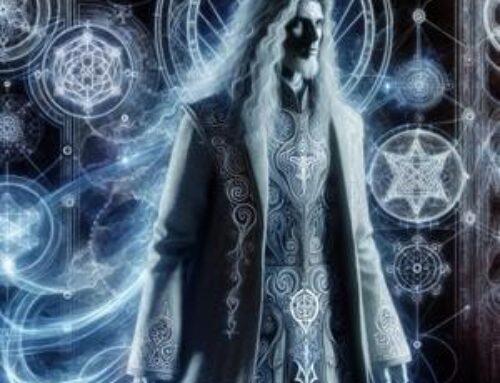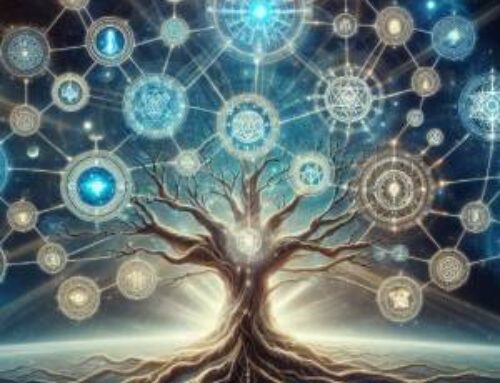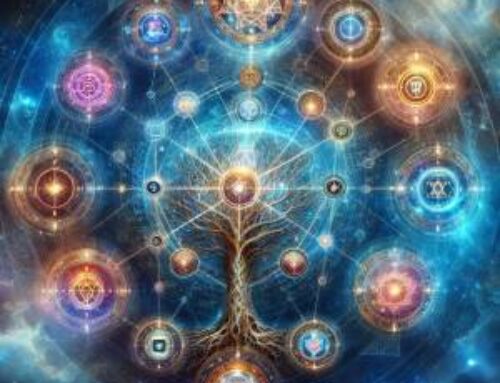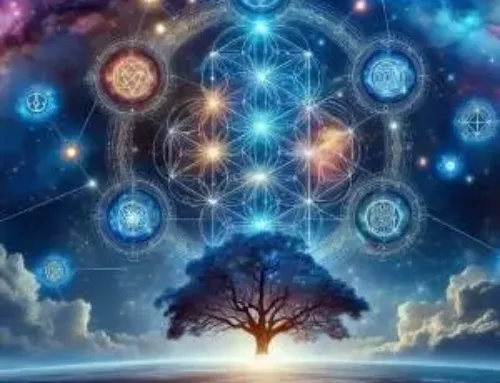Contents
Introduction to Yahweh Kabbalah
In the labyrinthine corridors of mystical traditions, where divine syllables shape the foundations of existence, the name Yahweh stands as a pillar of esoteric wisdom. “Yahweh Kabbalah” invites us into an arcane world where divine architecture constructs the universe’s vast expanses and intricate details. This exploration is not merely about understanding a name but uncovering the profound impact it has on the fabric of spiritual reality.
The primal tradition of the one and only revelation has been preserved under the name of Kabbalah by the priesthood of Israel (1).
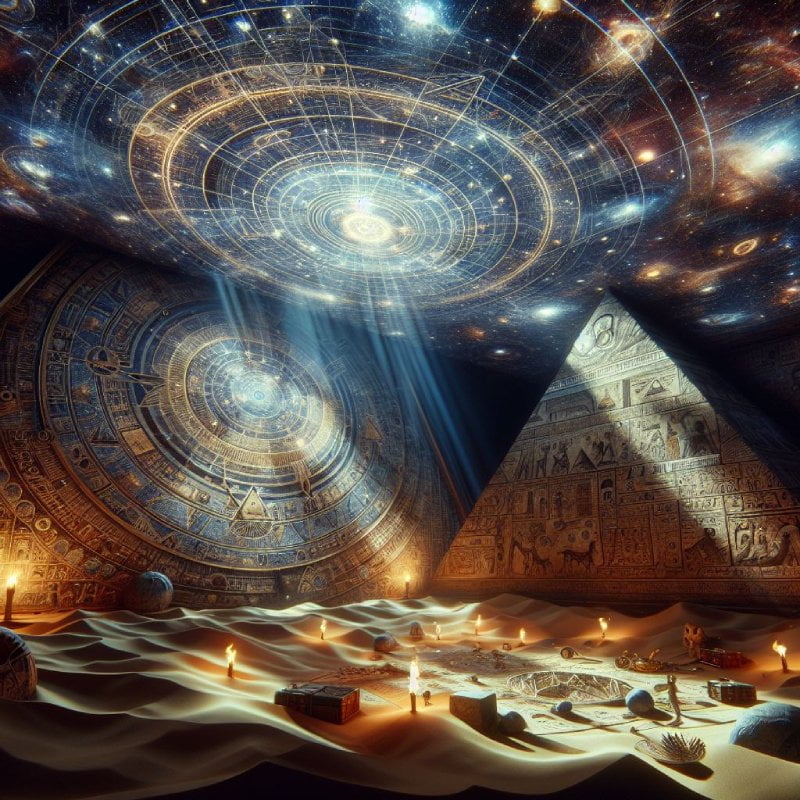
Yahweh Kabbalah offers a unique lens through which we can view the intricate mechanisms of divine creation. Kabbalistic teachings have long pondered over Yahweh, weaving it through the sinews of the Tree of Life, where it not only represents the genesis of being but also offers a map for returning to the Edenic state. Each utterance of Yahweh echoes through the spheres (Sephirot), activating channels of divine energy and enlightenment.
This article delves into the role of Yahweh within the Kabbalistic tradition, explores its integration with Hermetic and Rosicrucian practices, and unveils practical approaches for invoking this powerful name in pursuit of spiritual transformation.
The Mystical Aspect of God’s Name: The Tetragrammaton (YHVH) is considered deeply sacred, embodying the essence of the divine presence (2).
As we peel back the layers of these ancient teachings, we reveal how Yahweh Kabbalah serves as a gateway to transcending the mundane, guiding adherents through a metaphysical exploration that promises deeper understanding and spiritual elevation. In this exploration, Yahweh Kabbalah serves as both a mystical tradition and a practical approach to spiritual development
Divine Names and Their Power: The Role of Yahweh in Kabbalistic Tradition
Through Yahweh Kabbalah, we understand how divine names influence the cosmos and our spiritual path. In the intricate weave of Kabbalistic mysticism, the divine name Yahweh (Hebrew: YHVH) holds a paramount place, interlinking strands of cosmic creation, divine interaction, and the soul’s ascension towards enlightenment. The significance of this hallowed name surpasses the realms of mere nomenclature, providing a profound portal to comprehend the workings of the universe and the spiritual statutes that oversee it. Yahweh is not the correct pronunciation of the Tetragrammaton, but it is a version found in many scriptures.
The Essence of Yahweh in Kabbalistic Cosmology
Kabbalah, the secret doctrine stemming from Jewish mysticism, considers the name Yahweh not merely as a designation for the divine but as an essential component of the spiritual framework of the universe. Within the mystical construct of the Tree of Life, each of the ten Sephirot (spheres) emerges as an expression of God’s will and attributes, with Yahweh’s essence suffusing the conduits that link these spheres, steering the flow of divine energy.
The Sephiroth: Ten emanations represent the process of creation and the nature of the divine, forming a tree of life structure (3).
Creation and the Tetragrammaton
In the saga of creation articulated in Kabbalistic writings, Yahweh transcends the role of creator to become creation itself. Each character of the Tetragrammaton (YHWH) embodies a foundational element of the cosmos: Yod symbolizes the genesis of existence, Heh the expansion of space, Waw the realm of time, and the concluding Heh the totality of creation. This reading encourages followers to perceive Yahweh as the architectural blueprint of the universe, where each element fulfills a distinct role in the divine cosmic machinery.
Yahweh’s Role in Divine Interaction and Spiritual Practices Meditative Practices
Devotees of Kabbalah frequently employ the name Yahweh in meditative and reflective exercises to synchronize with divine vibrations. Chanting or focusing on the Tetragrammaton is thought to unlock streams of spiritual energy that can foster deep mystical revelations and insights, offering a pathway to rise from the earthly to the divine.
Stabilization of physiological rhythms, such as breathing, heart rate variability, or blood pressure variability, creates favorable conditions for achieving states of expanded consciousness, potentially improving efficiency, creativity, and spiritual growth (4).
Theurgical Invocations
The application of Yahweh in theurgical (ritual magic) operations within Kabbalah aims to capture the divine force inherent in the name to initiate change in the world and the adherent. These rites often include the invocation of Yahweh to consecrate the area, summon divine presence, and direct celestial forces for spiritual and material metamorphosis.
Yahweh and the Tree of Life
The Tree of Life, an emblematic symbol within Kabbalistic mysticism, intricately maps the divine influx from the ineffable Yahweh down to the material world. Understanding how Yahweh interfaces with the Sephirot on the Tree of Life not only deepens our comprehension of divine wisdom but also illustrates pathways to spiritual enlightenment. Yahweh Kabbalah intricately connects Yahweh with the Sephirot, illustrating a dynamic flow of divine energies.
Yahweh’s Architectural Role in the Sephirot
Framework of the Tree
The Kabbalistic Tree of Life features ten Sephirot, each embodying divine attributes that channel Yahweh’s essence from the abstract into the concrete. These Sephirot are arranged in three columns—representing mercy, severity, and balance—and are connected by twenty-two paths, each path offering a unique spiritual lesson and function, infused with the vibrations of Yahweh’s name.
The Tree of Life is formed by the Sephiroth constituting three distinct triads, each representing different aspects of the world: the intellectual world, the moral world, and the material world. These triads are structured with three masculine Sephiroth on the right, three feminine on the left, and four uniting Sephiroth in the center (5).
Yahweh in the Supernal Triad
- Kether (Crown): This is where the purest manifestations of Yahweh’s will are believed to reside. It is the point of creation where the light of Ein Sof (the Infinite) first condenses.
- Chokhmah (Wisdom) and Binah (Understanding): These spheres represent the dynamic outpouring of divine energy (Chokhmah) and the receptive container that shapes it into creation (Binah). Yahweh’s name here highlights the dynamic interchange between force and form, initiating the process of creation.
Yahweh’s Influence Through the Middle Pillar
- Tiphereth (Beauty): Yahweh’s attributes are mirrored in Tiphereth, where divine beauty and balance harmonize the flow of energy between the upper and lower realms. This Sephirah is crucial for mediating between the human and the divine, illustrating how Yahweh’s presence is central to spiritual development and harmony.
- Yesod (Foundation): Serving as the vital transmitter of the divine energies to Malkuth (Kingdom), the earthly realm, Yesod reflects Yahweh’s foundational role in creation. It is here that the divine plans become actionable realities, imbued with the purpose and direction of the Tetragrammaton.
Divine Names and Their Vibrational Power
Sacred Vibrations
Each divine name associated with Yahweh carries specific vibrations that align with the Sephirotic energies. These sacred sounds are used in meditation and prayer to invoke divine presence, align oneself with cosmic flows, and actualize spiritual potential in the physical world.
Practical Invocation
By chanting or meditating on the names of Yahweh associated with each Sephirah, practitioners can directly engage with these divine energies. This form of practical Kabbalah facilitates a transformative experience, allowing for a personal encounter with the divine attributes that Yahweh embodies.
Integrating Yahweh in Hermetic and Rosicrucian Practices The weaving of the divine name Yahweh into Hermetic and Rosicrucian traditions uncovers a profound amalgamation of Kabbalistic and Western esoteric philosophies (6). This fusion enhances both paths, furnishing a more nuanced framework for grasping and harnessing the mystical facets of Yahweh in spiritual endeavors.
Yahweh in Hermetic Philosophy Principles of Correspondence and Unity: Hermeticism, encapsulated by the axiom “As above, so below,” dovetails with Kabbalistic views of Yahweh’s role within the universe. The Hermetic tradition casts Yahweh not only as a creator but as a fundamental natural law manifesting through both the microcosm and macrocosm. This cosmic law is evident in Yahweh’s extensive influence across various existential planes, positing a unified divine operation that transcends traditional religious demarcations.
Alchemy and the Divine Name: In the alchemical lore, the name Yahweh represents the ultimate conversion of base substances into spiritual gold, epitomizing the soul’s metamorphosis into its divine state. Alchemists consider the invocation of Yahweh crucial during the stages of calcination and coagulation, where the soul is refined and merged with the divine, reflecting the mystical aims of Kabbalah.
Yahweh in Rosicrucian Rituals The Role of Sacred Names in Rituals: Rosicrucian customs employ the name Yahweh to sanctify space, summon divine safeguarding, and synchronize spiritual endeavors with divine intent. Within their ceremonies, Yahweh acts as a gateway to elevated sagacity and is frequently paired with other sacred names to trigger specific energies and maintain equilibrium and concord within the ritualistic structure.
Integration with Christian Mysticism: Rosicrucians commonly integrate Kabbalistic principles with Christian mysticism, where Yahweh is equated with the Tetragrammaton merged with the Christic energy. This blend affords a deeper, more arcane comprehension of Jesus’ doctrines and the divine nature in Christian Kabbalistic rites, enriching the spiritual voyage through a layered exploration of the godhead.
Practical Applications: Invoking Yahweh for Spiritual Transformation Meditation and Contemplation: Both Hermeticists and Rosicrucians engage in meditations centered on the divine attributes of Yahweh. These contemplations involve envisioning the sacred Tree of Life, chanting verses linked to Yahweh’s appellations, and employing breathwork to assimilate these divine forces. Such exercises are reputed to augment personal enlightenment, lift spiritual frequencies, and foster a more intimate connection with the divine.
Theurgical Practices: Theurgical acts are prevalent in both schools, where the name Yahweh is summoned to facilitate healing, protection, and spiritual enlightenment. These endeavors aim not solely at the practitioner’s benefit but also at realigning the world with divine ordinances, effecting a global ‘mending’ (Tikkun Olam) through both individual and collective spiritual exertions.
Conclusion
In the grand tapestry of esoteric traditions, “Yahweh Kabbalah” stands as a monumental pillar, intricately connecting the threads of divine wisdom across various mystical disciplines. Throughout this exploration, we have delved deep into the multifaceted roles and profound implications of the divine name Yahweh within the Kabbalistic tradition and its integration into Hermetic and Rosicrucian practices. Each aspect of our journey has not only highlighted the complex interplay between divine names and their power but also illuminated the structural and operational dynamics of Yahweh within the Sephirotic Tree of Life (7).
The discussions have traversed from the foundational elements of the Tree of Life, where Yahweh acts as both a creative force and an architectural blueprint of the cosmos, to the practical and theurgical applications that harness this potent name for spiritual transformation. By examining how Yahweh interfaces with the Sephirot to facilitate a comprehensive understanding of divine operations, we gain insights into the essential unity and balance necessary for spiritual ascent.
Moreover, the integration of Yahweh into Hermetic and Rosicrucian rituals enriches our understanding of these complex mystical systems, offering a broader perspective on the transcendent and immanent qualities of the divine. This synthesis not only bridges Kabbalistic wisdom with Western esoteric thought but also provides a robust framework for personal and collective spiritual practices.
Continue Your Journey in Mystical Traditions
Explore the profound dimensions of Yahweh Kabbalah further at the Hermetic Academy. Uncover more about divine names, the Tree of Life, and their esoteric implications by enrolling in our comprehensive courses.
FAQ – Yahweh Kabbalah
1. What is Yahweh Kabbalah?
A: Yahweh Kabbalah delves into the profound integration of the divine epithet Yahweh within the ambit of Kabbalistic wisdom, scrutinizing its interconnections to the Tree of Life and its utilization in Hermetic and Rosicrucian rites. This branch of study illuminates the crucial influence that this hallowed nomenclature exerts on the cosmic edifice and the devoted practices aimed at achieving enlightenment and personal transfiguration.
2. How does the name Yahweh influence the Kabbalistic Tree of Life?
A: Within Kabbalah, the appellation Yahweh permeates the Tree of Life, interfacing with the ten Sephirot that embody the array of divine characteristics. Each Sephirah serves as a vessel for Yahweh’s quintessence, diffusing His divine attribute through realms of compassion, stringency, and balance, thereby orchestrating the flux of divine force and fostering both cosmic genesis and the soul’s ascension.
3. Can Yahweh be used in practical Kabbalistic practices?
A: Indeed, the name Yahweh is central to a multitude of Kabbalistic practices, which include contemplative exercises and ritualistic ceremonies. Practitioners reciting Yahweh in meditation seek to resonate with divine vibrations, while ritual uses of Yahweh sanctify spaces, invoke divine protection, and precipitate spiritual transformation.
4. Where can I learn more about Yahweh Kabbalah?
A: For those eager to delve deeper into Yahweh Kabbalah and its esoteric principles, the Hermetic Academy presents extensive resources and scholastic programs. It offers a detailed curriculum that penetrates the incorporation of Yahweh within the tapestries of Kabbalistic, Hermetic, and Rosicrucian disciplines, fostering both scholarly insight and active application.
References:
(1) Eliphas, L. (1854). Dogme et Rituel de la Haute Magie. Paris.
(2) Mathers, S. L. M. (1887). The Kabbalah Unveiled. London.
(3) Mathers, S. L. M. (1887). The Kabbalah Unveiled. London.
(4) Jovanov, E. (2011). On Physiological Bases of States of Expanded Consciousness. , 203-221. https://doi.org/10.1007/978-3-642-18047-7_9.
(5) Mathers, S. L. M. (1887). The Kabbalah Unveiled. London.
(6) Rubenstein, E. (2023). Magic: The Legacy of the Rosicrucians. Hermetic World, Paphos.
(7) Rubenstein, E. (2020). The Tree of Life: The Kabbalah of Immortality. Hermetic World, Paphos.

